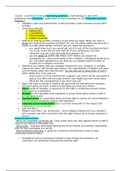Class notes
Business ethics and corporate responsibility
This is HRM 3660. class notes. BEST for the online version of the course. includes textbook notes, class notes, and a chart that includes all videos covered( which will be asked about on midterm)
[Show more]



